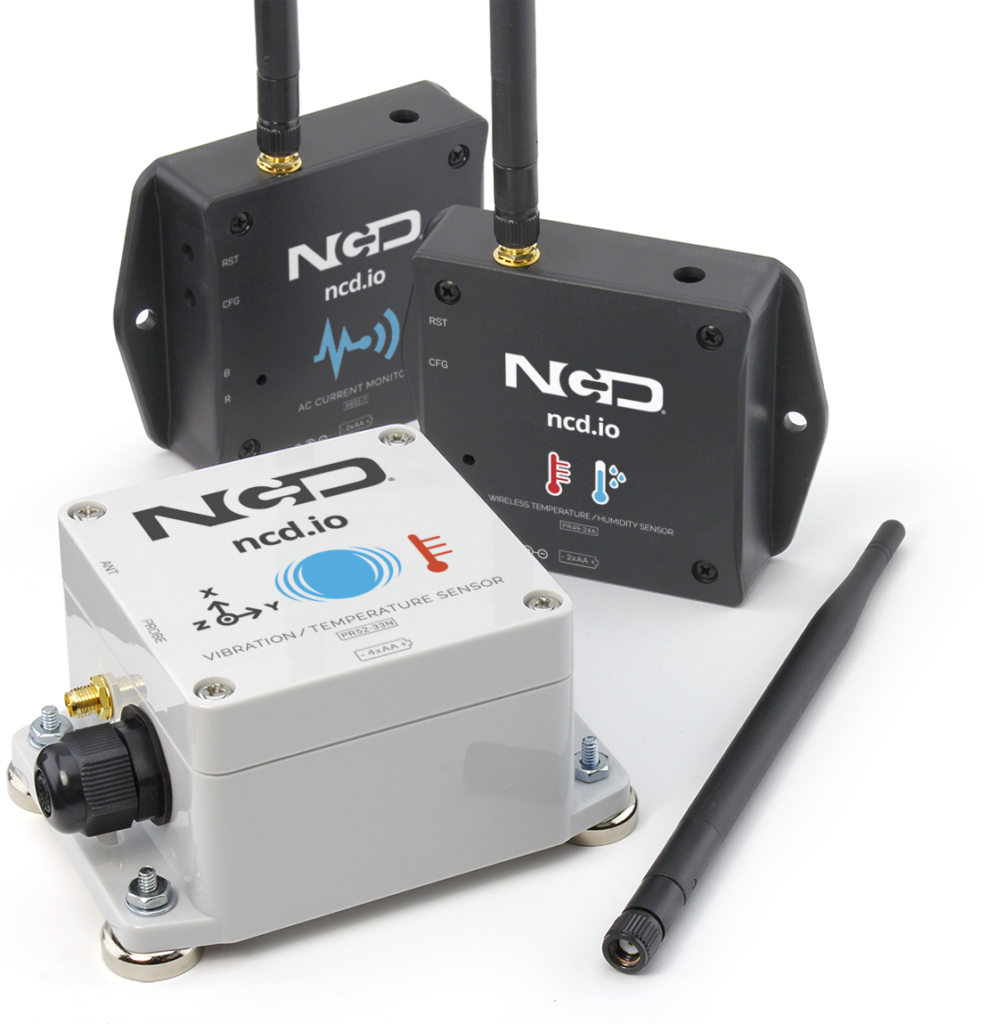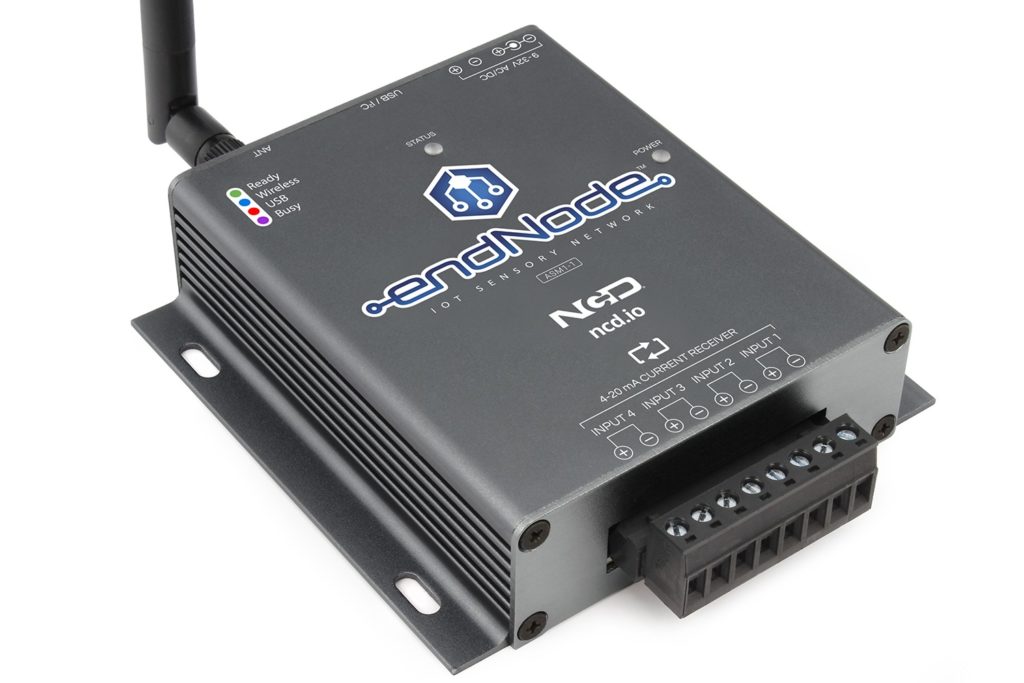IoT Sensors vs. IoT endNodes
As we continue to grow our pallet of IoT connected hardware, choosing the appropriate solution for your application might need a little context. You may find that we manufacture IoT endNodes and IoT Sensors that do the exact same thing, which could lead to some confusion. NCD engineers follow a rather large set of development guidelines for product classification and function. IoT endNodes and sensors seek to follow two distinct methods of operation, which covers the full gamut of our customers needs. While IoT Sensors and endNodes may have many similarities, there are some very important differences that should be considered before planning your next IoT integration. Here we will define our device classifications to help bring clarity to device selection.

IoT Sensors Definition
IoT Sensors are best defined as devices that wake up, gather real-world data, send data to cloud services, gateways, and modems, and then go back to sleep. IoT Sensors may be configured to wake up on interval or wake up when important changes are detected. In many cases, IoT sensors may wake on both conditions, depending on configuration. IoT sensors typically contain enough logic to send data only when necessary to preserve battery life, as IoT sensors are always battery powered. Some sensors may have the option of accepting external power. IoT Sensors are rated for a battery life of 300,000 transmissions or more, with most IoT sensors lasting in excess of 500,000 transmissions. Transmissions may be spread across a time duration of up to 10 years. IoT Sensors must include batteries that are capable of surviving the intended operational temperature range.
Physical access to IoT Sensors is required to change configuration settings as part of a secure sensor strategy. IoT Sensors are immune from remote attacks because they only send data one direction and spend most of their time sleeping. IoT Sensors are encrypted using a minimum 128-bit AES encryption to further secure the integration solution. IoT Sensors may be grouped, so it is possible to put many kinds of IoT sensors on each floor of a high-rise building while each floor of the building remains digitally isolated from each floor. IoT Sensors may connect directly to the internet or connect to the internet through a gateway. IoT Sensors can communicate to one or more destinations, including Modems for localized sensor processing using Node-Red (or your own custom software) or Gateways for cloud connectivity to popular cloud platforms such as MQTT, Amazon AWS, Microsoft Azure, Losant, and more.
IoT sensors are typically used for monitoring vibration, temperature, humidity, pressure, energy, water, light, and more. IoT sensors, from a broad perspective, collect many types of real-world data and communicate these data to one or more destinations. Because IoT sensors are a data collection and transmission device with very low power requirements, they have no ability to accept data from a remote computer or control any form of outputs.
IoT endNodes Definition

IoT endNodes are typically used for input and output operations and may be used in about everything from live sensor monitoring to relay output functionality. endNodes may include a wide variety of input and output combinations and functionality. endNodes are typically used in applications that require instant access to a remote device or if you need to react to sensors in other locations. Because endNodes support live communications with a computer, additional features were added to make endNodes expandable using the integrated I2C expansion port. The core functionality of endNodes is to convert incoming data into I2C communications, which is the prevailing format for communications to every sensor ever created. Since endNodes is simply an intelligent conversion technology, it’s ability to expand into the future is unlimited. This means that endNodes may be connected to sensors that have not yet been created.
ProXR Enterprise is also a major feature of endNodes. ProXR Enterprise is our latest generation relay control command set, making relay control easier and more expandable than ever, with some endNode devices capable of controlling 2,048 relays. The ProXR Enterprise command set makes it easy to turn relays on or off, pulse relays, or toggle the state of relays. Send commands to trigger relay timers, which allow relay control over a duration of time. Integrated Macro features allow you to send simple commands that execute a list of functions, greatly simplifying complex tasks.
Contrasting IoT Sensors and IoT endNodes
IoT Sensors
- Battery Powered Devices that Wake Up and Send Data
- Usually Support Waking on Interval or Waking when Event is Detected
- Typically Rated for 300,000 or More Data Transmissions
- Transmissions May be Spread over a 10 Year Period of Time
- Require Physical Access to Change IoT Sensor Settings
- Capable of Transmitting to Multiple Gateways and Sensors
- Configured over Wireless Communications
- For Use in Sensing Applications Only
- Wireless Communications Only
Applications
- Temperature and Humidity Sensing
- Pressure Sensing
- Water Detection
- Thermocouple Temperature Monitoring
- Air Quality Monitoring
- Current Monitoring
- Contact Closure Push Notification
- Contact Closure Counting
- Voltage Measurement
- 4-20mA Input Monitoring
- Isolated Voltage Detection
- Door Open Close Detection and Alerts
Communications Architecture
- Spontaneous Transmission on Interval
- Spontaneous Transmission when Significant Changes are Detected
- One Sensor Broadcasts to Many Modems and Gateways
Access Points
- IoT Sensors Send Data to Modems and Gateways
- Use Modems for Communications to Local Computers
- Use Gateways for Communications to Popular Cloud Platforms
IoT endNodes
- Constantly Powered and Waiting for Data Requests
- Speaks Only when Spoken to, Never Sends Spontaneous Data
- Compatible with Multiple Modems and Gateways
- Talks Only to One Gateway or Modem at a Time
- Configured Over USB Communications
- For Use in Sensing and Control Applications
- Ethernet, RS-232, RS-485, Industrial Wireless Communication Options
- Expandable using the I2C Communications Command Set
- Integrated ProXR Enterprise Relay Control Command Set
Applications
- Current Monitoring
- Relay Control
- 4-20mA Input Measurement
- 4-20mA Output Control
- PWM and DAC Control
- Gas Sensing (Requires a Continuous Power Supply)
- Programmable GPIO and Control
- Isolated Voltage Detection
- FET Output control
- Temperature and Humidity Sensing
- Pressure Sensing
- Water Detection
- Thermocouple Temperature Monitoring
- Air Quality Monitoring
Communications Architecture
- Waits for a Command, Processes Request, Responds with Result
- Speaks to Only One Modem/Gateway at a Time
- Will Privately Respond to Multiple Modems and Gateways
Access Points
- Use Modems for Communications to Local Computers
- Development of endNode Gateways is Currently in Progress
Similarities Between IoT Sensors and IoT endNodes
Both technologies support long-range wireless communications and offer 128-Bit AES Encryption standards (minimum). While many other communication technologies are available, the long-range wireless 900MHz version remains the most prevalent to our user base. Both technologies also support grouping, which allows for digital separation of devices to reduce wireless communications conflicts. Both technologies are a great choice for a wide variety of sensing applications and we are typically able to add features and sensor types upon request.

